How Much Energy Do Washers and Dryers Use?
If you’re trying to be mindful about how much energy you’re using at home, it makes sense to focus on major appliances like your washer and dryer. How much energy are these big, boxy appliances really using? And is there anything you can do to reduce their energy consumption?
Let’s take a closer look at these machines, starting with the clothes washer.
How Much Energy Does a Washing Machine Use?
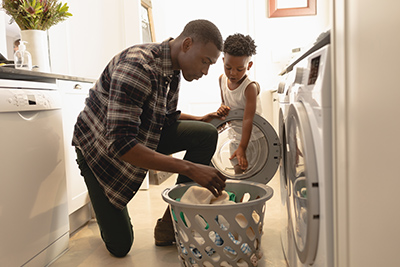
Compared to other large appliances like furnaces, air conditioners and refrigerators, washing machines don’t consume a huge amount of energy. Even the most sophisticated models usually have just a few parts that use energy: an electric motor that turns an agitator or drum, water pumps that fill and drain the machine and a simple electronic control panel account for most of the machine’s energy needs.
Wattage of a Washing Machine
According to EnergySage, an energy information portal and marketplace funded by the U.S. Department of Energy, the typical wattage of a washing machine averages between 400 and 1,400 watts of electricity. If you use a washing machine three times a week, EnergySage estimates that this will consume about 140.4 kilowatt-hours (kWh) of electricity per year, at a cost of around $19.92 annually.
But there’s an important factor this figure doesn’t take into account: hot water. If you typically wash your clothes in cold water, that’s great – there’s no need for you to factor in other appliances. But if you wash in warm or hot water, that puts pressure on your water heater, which is a much more energy-hungry appliance.
How Much Water Does a Washing Machine Use?
Accurately calculating the total energy use per load of a washing machine using warm or hot water is complicated, because water heaters vary widely in their efficiency, and there’s no one-size-fits-all capacity for washing machines. So instead of breaking out the calculator, it’s best to check the EnergyGuide label for operating cost estimates based on the type of water heater you have.
The EnergyGuide label is a bright yellow and black label that is required by federal law for manufacturers of new major appliances and certain electronics. It includes standardized estimates of energy consumption and operating costs, which make it easier for consumers to compare the energy efficiency of different appliance models. The EnergyGuide label for washing machines will have three important data points:
- Estimated yearly energy cost. This is expressed as a dollar amount, which is based on the average kWh rate of electricity and water heating with an electric water heater.
- Estimated yearly electricity use. This is expressed in kWh, and only applies to the electricity consumption of the washing machine itself.
- Alternate estimated yearly energy cost. This is expressed as a dollar amount and is based on use with a natural gas water heater. This amount is typically lower than the yearly cost estimate based on an electric water heater.
When shopping online or at retail, you may find the EnergyGuide label clearly displayed. But if you don’t, or if you want to see the EnergyGuide label for an appliance you already own, you may need to go to the website of your washing machine’s manufacturer and search for it by model number.
How Much Energy Does a Dryer Use?
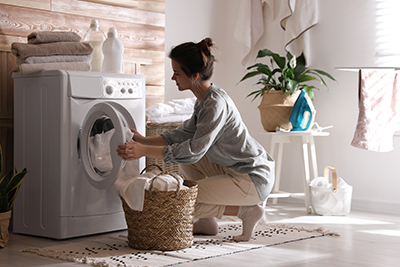
While estimating the energy consumption of a washing machine can be complicated, estimating the energy demands of a dryer can be even more so. One of the primary reasons for this is that federal law does not mandate EnergyGuide labels for dryers, so you can’t easily compare dryer efficiencies at a glance.
Further complicating this question is the fact that most dryers are available in both electric and natural gas models, and most residential laundry rooms only have hookups for one type. In general, gas dryers are more efficient and cost less to operate than electric dryers. The main trade-off is that gas dryers usually have a higher upfront cost.
Dryer Wattage and BTU Output
EnergySage reports that the average dryer wattage for an electric dryer is between 1,500 and 5,000 watts of electricity – a wide range. Based on EnergySage’s estimates, using the average electric dryer three times per week will use about 468 kWh of electricity, costing around $66.41 per year. Natural gas is commonly measured in British Thermal Units (BTUs), and gas dryers are rated for their maximum BTU output, typically between 20,000 and 25,000 BTUs.
But the actual energy use of a dryer during a typical cycle is usually less than these wattages and BTU ratings suggest. That’s because most of a dryer’s energy use comes from its heater, which turns on and off during the course of a cycle to maintain a desired temperature. Furthermore, that temperature varies depending on what dryer settings you’re using.
If you’re shopping for a new dryer with energy efficiency in mind, there are two things to look for. The first is the ENERGY STAR label, which is awarded to dryers that use at least 20 percent less energy than conventional dryers (you can also look for the ENERGY STAR label on washing machines, which is awarded to models that use 35 percent less water and 25 percent less energy than conventional washers).
The second thing you should look for is a moisture sensing feature. Dryers with moisture sensors automatically shut off when a load of laundry is dry, saving both energy and wear-and-tear on the appliance.
How to Save Energy When Using Your Washer and Dryer
Regardless of whether you have a newer energy-efficient washer and dryer or less efficient older models, there are a few tips and tricks you can use to help keep your energy bills as low as possible:
- Clean your dryer’s lint filter after every load. This not only helps minimize the risk of accidental fire, it reduces strain on your dryer’s blower and heater, saving energy. Every few months, remove the lint filter and clean it thoroughly with soapy water.
- Wash with cold water. Some tough cleaning jobs may call for warm or hot water, but for most everyday washing, cold water works just fine.
- Don’t overfill your dryer. There should be enough room for your clothes to tumble freely, which allows them to dry as quickly as possible.
- Wash full loads whenever possible. Your washing machine will use the same amount of energy to wash a full load as it will a small load, so this helps you get the most bang for your buck.
- Dry clothes in consecutive loads. If you throw wet clothes in the dryer while it’s still warm from the previous load, the heater will use less energy.
- Air-dry clothes when possible. Even if you don’t have space to hang a clothesline outdoors, you can use foldable drying racks to hang-dry several garments in a small indoor space.
- Use the lowest appropriate dryer heat setting. Thick blankets and towels may require high-heat drying, but for average loads, choosing low or medium heat will conserve energy.
- Make sure your moisture sensor is activated. If your dryer has this feature, check to ensure it’s on and working. You should also follow your manufacturer’s directions for periodically cleaning the sensor.
- Take advantage of time-of-day pricing. If your electricity provider offers lower kWh rates during off-peak times, save your laundry until nighttime to rake in the savings.
Looking for Something Specific?
Select a category to find resources for topics that interest you.
Select Category

Related Articles:
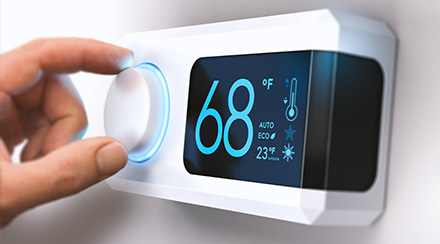
Tips for Improving Your AC and Furnace Efficiency
We share maintenance tips for your heater and AC, and home improvement tips to help you use those systems less.
Read Article
Tips for Saving on Energy in Your Home
If you’re looking to learn more about energy efficiency for home systems and appliances, we’re sharing our favorite energy-saving tips.
Read Article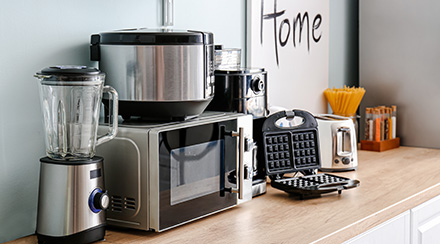
What Uses the Most Electricity In a Home?
We break down what uses the most energy in your home to give you an understanding of where your energy usage goes and where energy-saving tactics can make the most impact.
Read ArticleMost Popular Articles
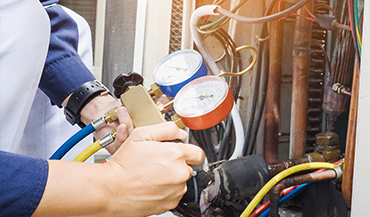
Keep Your HVAC Running Efficiently
Airtron's HVAC services can help keep your AC and heater running efficiently so you can stay comfortable while saving energy. Learn More.
How Much Energy Do Washers and Dryers Use?
If you’re trying to be mindful about how much energy you’re using at home, it makes sense to focus on major appliances like your washer and dryer. How much energy are these big, boxy appliances really using? And is there anything you can do to reduce their energy consumption?
Let’s take a closer look at these machines, starting with the clothes washer.
How Much Energy Does a Washing Machine Use?
Compared to other large appliances like furnaces, air conditioners and refrigerators, washing machines don’t consume a huge amount of energy. Even the most sophisticated models usually have just a few parts that use energy: an electric motor that turns an agitator or drum, water pumps that fill and drain the machine and a simple electronic control panel account for most of the machine’s energy needs.
Wattage of a Washing Machine
According to EnergySage, an energy information portal and marketplace funded by the U.S. Department of Energy, the typical wattage of a washing machine averages between 400 and 1,400 watts of electricity. If you use a washing machine three times a week, EnergySage estimates that this will consume about 140.4 kilowatt-hours (kWh) of electricity per year, at a cost of around $19.92 annually.
But there’s an important factor this figure doesn’t take into account: hot water. If you typically wash your clothes in cold water, that’s great – there’s no need for you to factor in other appliances. But if you wash in warm or hot water, that puts pressure on your water heater, which is a much more energy-hungry appliance.
How Much Water Does a Washing Machine Use?
Accurately calculating the total energy use per load of a washing machine using warm or hot water is complicated, because water heaters vary widely in their efficiency, and there’s no one-size-fits-all capacity for washing machines. So instead of breaking out the calculator, it’s best to check the EnergyGuide label for operating cost estimates based on the type of water heater you have.
The EnergyGuide label is a bright yellow and black label that is required by federal law for manufacturers of new major appliances and certain electronics. It includes standardized estimates of energy consumption and operating costs, which make it easier for consumers to compare the energy efficiency of different appliance models. The EnergyGuide label for washing machines will have three important data points:
- Estimated yearly energy cost. This is expressed as a dollar amount, which is based on the average kWh rate of electricity and water heating with an electric water heater.
- Estimated yearly electricity use. This is expressed in kWh, and only applies to the electricity consumption of the washing machine itself.
- Alternate estimated yearly energy cost. This is expressed as a dollar amount and is based on use with a natural gas water heater. This amount is typically lower than the yearly cost estimate based on an electric water heater.
When shopping online or at retail, you may find the EnergyGuide label clearly displayed. But if you don’t, or if you want to see the EnergyGuide label for an appliance you already own, you may need to go to the website of your washing machine’s manufacturer and search for it by model number.
How Much Energy Does a Dryer Use?
While estimating the energy consumption of a washing machine can be complicated, estimating the energy demands of a dryer can be even more so. One of the primary reasons for this is that federal law does not mandate EnergyGuide labels for dryers, so you can’t easily compare dryer efficiencies at a glance.
Further complicating this question is the fact that most dryers are available in both electric and natural gas models, and most residential laundry rooms only have hookups for one type. In general, gas dryers are more efficient and cost less to operate than electric dryers. The main trade-off is that gas dryers usually have a higher upfront cost.
Dryer Wattage and BTU Output
EnergySage reports that the average dryer wattage for an electric dryer is between 1,500 and 5,000 watts of electricity – a wide range. Based on EnergySage’s estimates, using the average electric dryer three times per week will use about 468 kWh of electricity, costing around $66.41 per year. Natural gas is commonly measured in British Thermal Units (BTUs), and gas dryers are rated for their maximum BTU output, typically between 20,000 and 25,000 BTUs.
But the actual energy use of a dryer during a typical cycle is usually less than these wattages and BTU ratings suggest. That’s because most of a dryer’s energy use comes from its heater, which turns on and off during the course of a cycle to maintain a desired temperature. Furthermore, that temperature varies depending on what dryer settings you’re using.
If you’re shopping for a new dryer with energy efficiency in mind, there are two things to look for. The first is the ENERGY STAR label, which is awarded to dryers that use at least 20 percent less energy than conventional dryers (you can also look for the ENERGY STAR label on washing machines, which is awarded to models that use 35 percent less water and 25 percent less energy than conventional washers).
The second thing you should look for is a moisture sensing feature. Dryers with moisture sensors automatically shut off when a load of laundry is dry, saving both energy and wear-and-tear on the appliance.
How to Save Energy When Using Your Washer and Dryer
Regardless of whether you have a newer energy-efficient washer and dryer or less efficient older models, there are a few tips and tricks you can use to help keep your energy bills as low as possible:
- Clean your dryer’s lint filter after every load. This not only helps minimize the risk of accidental fire, it reduces strain on your dryer’s blower and heater, saving energy. Every few months, remove the lint filter and clean it thoroughly with soapy water.
- Wash with cold water. Some tough cleaning jobs may call for warm or hot water, but for most everyday washing, cold water works just fine.
- Don’t overfill your dryer. There should be enough room for your clothes to tumble freely, which allows them to dry as quickly as possible.
- Wash full loads whenever possible. Your washing machine will use the same amount of energy to wash a full load as it will a small load, so this helps you get the most bang for your buck.
- Dry clothes in consecutive loads. If you throw wet clothes in the dryer while it’s still warm from the previous load, the heater will use less energy.
- Air-dry clothes when possible. Even if you don’t have space to hang a clothesline outdoors, you can use foldable drying racks to hang-dry several garments in a small indoor space.
- Use the lowest appropriate dryer heat setting. Thick blankets and towels may require high-heat drying, but for average loads, choosing low or medium heat will conserve energy.
- Make sure your moisture sensor is activated. If your dryer has this feature, check to ensure it’s on and working. You should also follow your manufacturer’s directions for periodically cleaning the sensor.
- Take advantage of time-of-day pricing. If your electricity provider offers lower kWh rates during off-peak times, save your laundry until nighttime to rake in the savings.
Looking for Something Specific?
Select a category to find resources for topics that interest you.
Select Category

Related Articles:

Tips for Improving Your AC and Furnace Efficiency
We share maintenance tips for your heater and AC, and home improvement tips to help you use those systems less.
Read Article
Tips for Saving on Energy in Your Home
If you’re looking to learn more about energy efficiency for home systems and appliances, we’re sharing our favorite energy-saving tips.
Read Article
What Uses the Most Electricity In a Home?
We break down what uses the most energy in your home to give you an understanding of where your energy usage goes and where energy-saving tactics can make the most impact.
Read ArticleMost Popular Articles

Keep Your HVAC Running Efficiently
Airtron's HVAC services can help keep your AC and heater running efficiently so you can stay comfortable while saving energy. Learn More.







